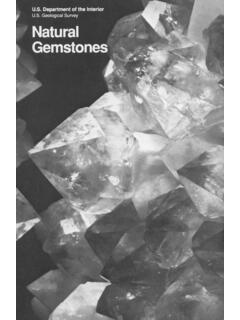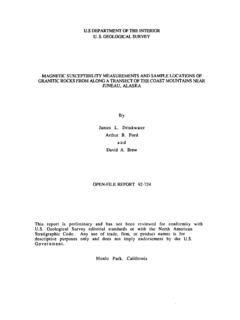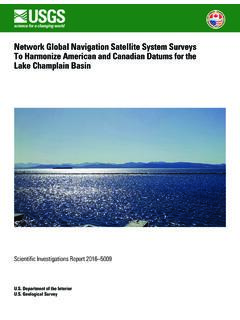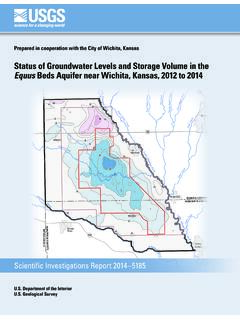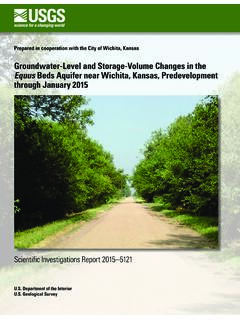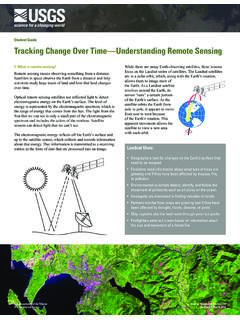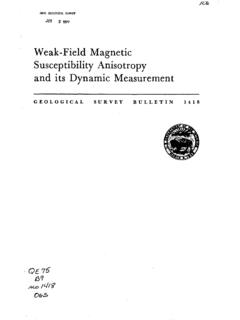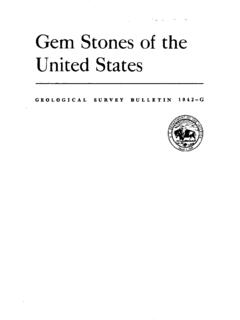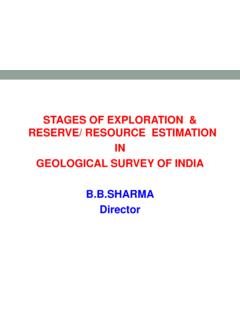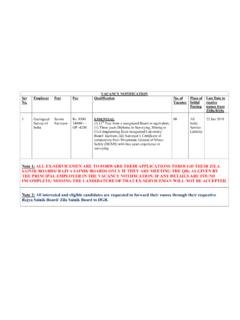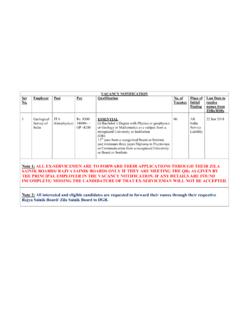Transcription of GEOLOGICAL SURVEY - USGS
1 DE-PAKTMEHT OF THE TUTBEIOliOF THKUNITED STATESGEOLOGICAL SURVEY . 184 SERIES A, ECONOMIC CEOLOOY, 13 WASHINGTONOOVKllNMENT PRINTING OFFICE 1901 UNITED STATES GEOLOGICAL SURVEYCHARLES D. WALCOTT, DIRECTOROIL AND GAS FIELDSOF THEBIAS COALAND OF THEUPPER CRETACEOUS AND TERTIARY OF THE ' WESTERN GULF COASTBYG-EORG-E I. ADAMSWASHINGTONGOVERNMENT PRINTING OFFICE 1901 OIL AND GAS FIELDS OF THE WESTERN INTERIOR AND NORTHERN TEXAS COAL MEASURESGEORGE I.. 11 Location of the Coal Measure areas .. 11 Character of the sediments .. 11 General structure .. 12 Origin of the oil and .. 12 Discovery of the . ;.' ..'.. 12 Present productive area .. 12 Geology of the Kansas-Indian Territory .. 18 Lower Carboniferous .. 13 Mississippian .. 13 Upper Carboniferous 14 Cherokee shales or lower formations.
2 14 Fort Scott .. 15 Higher 15 Structure of the oil and gas ..'. 16 Oswego-Independence section .. 16 Fort Scott-Iola ..'., 17 Chelsea-Bartlesville , .. 17 Deformation of the field .. , .. 18 Conditions of the occurrence of oil and 19 Development in the Kansas-Indian Territory field .. 21 Louisburg, Lacygne, and Mound 21 Osawatomie .. 21 Fort .. '. 21 Wyandotte, Rosedale, and Kansas 21 Greeley .. 22 Western border of 22 Tola and La '.. ' .. 24 Peru .. 24 Cherry vale .. 24 Coffeyville ..^.. 24 Benedict .. 25 Neodesha field and .. 25 Guilford ..:.. ,.. 2578 in the Kansas-Indian Territory field Continued..;.. 26 Mound Valley .. 26 Neosho Falls .. 26 Chelsea, Indian 26 Bartlesville, Indian Territory .. 26 Red Fork, Indian .. 26 Value of the oil and gas produced in the Kansas-Indian Territory field.
3 26 Oil and gas in central Indian Territory and western 28 Oil and gas in the northern Texas Coal Measure area .. PLATE I. Map showing oil and gas localities of the Western Interior andnorthern Texas Coal Measures and area of special map .. 11It. GEOLOGICAL map of the special area of the gas and oil fields of the Western Interior Coal Measures, with sections through Fort Scott and lola (A A), Oswego and Independence (B B), and Chelsea and Bartlesville (C C) .. 16 FIG. 1. Vertical column of the Kansas Coal 16U. S . GEOLOGICAL SURVEYBULLETIN No. 184. PL. IJULIUS BIEN 6 CO. LITH. SHOWING OIL AND GAS LOCALITIESOF THEWESTERN INTERIOR AND NORTHERN TEXAS GOAL MEASURES AND AREA OF SPECIAL MAPBY GEORGE I, 5 OScale 1003OO MI LE SOIL AND GAS FIELDS OF THE WESTERN INTERIOR AND NORTHERN TEXAS COALBy GEORGE I.
4 Of the Coal Measure areas. The rocks of Coal Measure age which constitute the coal fields of the United States lying between the Mississippi River and the Rocky Mountains outcrop in two areas. The larger is known as the Western Interior coal field. It extends from southern Iowa through northwestern Missouri, the southeastern portion of Nebraska, and the eastern part of Kansas into eastern Oklahoma, Indian Territory, and the western part of Arkansas. It is bordered on the south by the Arbuckle and Ouachita mountains. To the south of the Arbuckle Mountains, in Indian Territory, and extend- ing into Texas beyond the Colorado River, is the smaller area, known as the Northern Texas coal field. The southern border of this field is the mountainous region of central of the sediments. The rocks of Coal Measure age are a portion of a vast sheet of sediments deposited during Upper Carbon- iferous time, and were laid down as sands and muds in seas of Avide extent.
5 The vertical section of the formations in Kansas measures approximately 2,500 feet (see fig. 1, on p. 16). At the base of these rocks there are 450 feet of shales and sandstones, while above this por- tion interstratified limestones are a conspicuous element. The Coal Measure rocks in Missouri and Iowa are similar in character to those of Kansas. In Indian Territory and Arkansas the section aggregates more than 12,000 feet and is composed almost wholly of sandstones and shales. This section includes at the base a great thickness of sediments, probably aggregating 9,000 feet, which are not represented farther north. In the Texas area the basal portion of the section is likewise composed largely of sandstones and shales, while in the upper part limestones are prominent. The character of the sediments and the structure and geologic history of the region as a whole indicate that1112 OIL AND GAS FIELDS OF WESTERN INTERIOR, ETC.
6 [BULL. the time of deposition land areas were adjacent to the deposits in Indian Territory and Arkansas and that from them the great mass of material which constitutes the sandstone and shale formations was derived. More open-sea conditions seem to have prevailed in the remoter portion of the Coal Measure sea, especially in the later part of the period, arid consequently the sediments were frequently of calcareous character and- formed structure. The eastern limit of the present exposure of the Coal Measure rocks in the Western Interior field is the contact of the base of the series with older rocks. Along their western border they pass under younger sediments. In the southeastern part of the Indian Territory and in Arkansas the rocks have a folded structure, but in the remaining portions of the field they have a relatively slight west- erly inclination and regular dips.]
7 The rocks in the Texas coal field dip to the west. On their western border they are concealed by the Permian formation and on the eastern border by the Cretaceous. SOrigin of the oil and gas. The shales of the Coal Measures are very bituminous and give evidence of the presence of organic matter in great abundance at the time of their deposition. The burying of this material and its subsequent decomposition under cover of the overlying sediments and the continental seas is regarded as having given rise to the oil and gas. The reservoirs in which these products were received were the sandstones and more porous beds. Where these formations outcrop at the surface they not infrequently give off an odor which suggests oil; and gas springs and seeps, as well as maltha, were noted by the earlier explorers and were considered indications of valuable deposits of petroleum.
8 These occurrences represent surface leakages. The valuable supply consists of such bodies as exist in the permanent reservoirs which are deeply buried by superincumbent of the field. With the beginning of the settlement of the Country some prospecting was done, and predictions were made that oil would be found in this field. In 1860 a company was organized which did some drilling in the hope of finding petroleum; and an active interest was taken in the SURVEY of Miami County by the first geolog- ical SURVEY of Kansas because of the tar springs which occur there. With the sinking of deep wells for water and the occasional drilling of prospect holes for coal other indications appeared. Borings which penetrated the formations where they are under sufficient cover and have a structure which retains the oil and gas have revealed the present productive fields.
9 Many of the earlier indications of gas were for a long time neglected because those who drilled the wells were looking for coal and did not care to prospect for oil and gas. An instance of this is the Acres well at lola, drilled in 1873, which furnished water for a mineral-water resort and gave off sufficient gas to burn with a constant flame. Later prospecting in this vicinity resulted in the discovery of the lola gas ] MISSISSIPPIAN LIMESTONE. 13 Present productive area. About 1890 outside capital came into the field, interest in the oil and gas resources became very active, and many commercial enterprises developed. At present the productive territory is being constantly extended, as there is a demand for the gas as fuel, and the oil is proving to be a profitable resource. The principal productive field of the Western Interior area is in south- eastern Kansas and the northern part of Indian Territory, although both gas and oil in limited quantities have been found as far north as Kansas City and along the western border of Missouri.
10 The Coal Measure rocks of Iowa have thus far not proved productive. The small flows of gas which have been encountered in that State are from the glacial deposits and are of sporadic occurrence. The exploita- tion of the field has been attended with considerable uncertainty and pecuniary risk. Considering the number of wells and the limited areas which have been developed in the various localities, the per- centage of producing wells is encouraging. The northern Texas area can not be considered as having been exploited very largely, and it may not prove to contain large deposits, although the number of wells which shoAV gas and oil are sufficient to warrant further OF THE KANSAS-INDIAN TERRITORY FIELD LOWEK that portion of the Coal Measures of southern Kansas and northern Indian Territory which at present constitutes a productive oil and gas field the rocks have a very simple structure.
